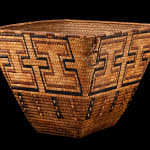-
Artworks
UNIDENTIFIED THOMPSON RIVER SALISH (NLAKA'PAMUX) ARTIST
Burden Basket, 19th centurycedar bark, cherry bark, natural and dyed bear grasses, and doe skin, 10 x 12.25 x 14.75 in (25.4 x 31.1 x 37.5 cm)LOT 148
ESTIMATE: $1,800 — $2,800
PRICE REALIZED: $3,600.00Further images
Named aptly for their function, burden baskets are a crafted mix of purpose and design. The trapezoidal shape of the basket is one of the oldest examples of Indigenous basketry,...Named aptly for their function, burden baskets are a crafted mix of purpose and design. The trapezoidal shape of the basket is one of the oldest examples of Indigenous basketry, the gentle slope allowing for large amounts of food or raw ingredients to be carried without everything at the bottom being crushed under the weight. The wide, flat sides of the basket allow for a large canvas for design, in this instance bifurcated in the centre to create two distinctly different areas of design. The tight and neat stitches of the woven designs sit like geometric rows of corn kernels, punctuated by the colours of the cherry bark and dyed grasses.
References: For a detailed introduction to Thompson River Salish (Nlaka’pamux) baskets, see Karen Petkau, Baskets: Carrying a Culture. The Distinctive Regional Styles of Basketmaking Nations in the Pacific Northwest, Bachelor, University of Victoria, Victoria, British Columbia, 2022. See also Sarah Peabody Turnbaugh & William A.Turnbaugh, Indian Baskets, (West Chester, PA: Schiffer Publishing Ltd. in collaboration with the Peabody Museum of Archaeology and Ethnology, Harvard University, 1986), pg 168. See Thompson and Lillooet baskets in Allan Lobb, Indian Baskets of the Pacific Northwest and Alaska, (Portland: Graphic Arts Center Publishing Company, 1990), pp. 50-60.
Provenance
A Vancouver Collection.
Join our mailing list
* denotes required fields
We will process the personal data you have supplied in accordance with our privacy policy (available on request). You can unsubscribe or change your preferences at any time by clicking the link in our emails.












